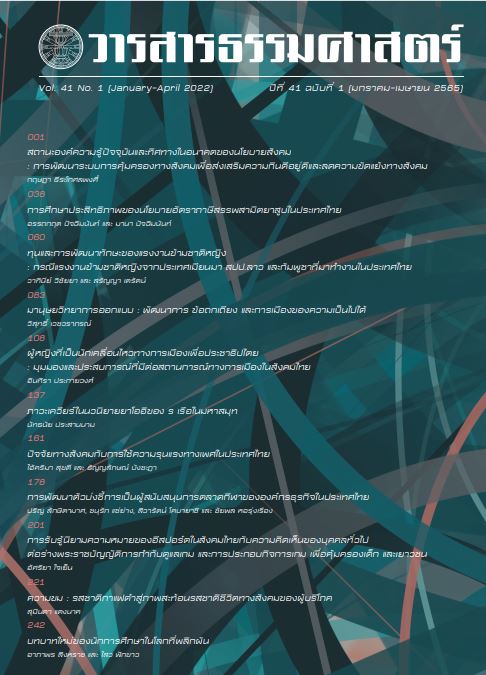The development of indicators for sports marketing sponsorship of business organizations in Thailand
Main Article Content
Abstract
The research was aimed at studying the development and checking validity of indicators for sports marketing sponsorship of business organizations in Thailand. The questionnaires were constructed as a research tool for collecting data from 756 samples of business organizations registered in the Stock Exchange of Thailand. The data was analyzed using a confirmation elementary analysis technique by analyzing a measurement model. The research findings indicated that the indicators for sport marketing sponsorship were developed model was parallel with the empirical data consisted of 39 indicators in 13 factor components as factor 1: controlling office organization with 3 indicators, factor 2: sport club member with 3 indicators, factor 3: supporters with 3 indicators, factor 4: channel of communication with 3 indicators, factor 5: convenience with 3 indicators, factor 6: activity with 3 indicators, factor 7: specific sports with 3 indicators, factor 8: target market with 3 indicators, factor 9: brand image enhancement with 3 indicators, factor 10: extensive territory enlargement with 3 indicators, factor 11: brand engagement with 3 indicators, factor 12: efficient support with 3 indicators and factor 13: factors of non-supporters with 3 indicators. Each component had convergent validity because the construct reliability was more than 0.60 and the factor loading was more than 0.30. Suggestions for concerning parties should encourage the integrated marketing communications along with various appropriate activities including business alliances with other networks’ groups buildable for extensive knowledge, creative thinking and skills in activity operations and problem solvings including ethical appropriation setup seeding for the participation and mutual responsibility.
Article Details
References
กัลยา วานิชย์บัญชา. (2560). การวิเคราะห์สถิติขั้นสูงด้วย SPSS for Windows. (พิมพ์ครั้งที่ 12). กรุงเทพฯ: สามลดา, 75-78.
ณรงค์ โพธิ์พฤกษานันท์. (2551). ระเบียบวิธีวิจัย. กรุงเทพฯ: เอ็กซเปอร์เน็ท, 52-60.
ตลาดหลักทรัพย์แห่งประเทศไทย. (2562). รายชื่อบริษัทที่จดทะเบียนในตลาดหลักทรัพย์แห่งประเทศไทย. สืบค้น 16 กุมภาพันธ์ 2562, จาก https://www.set.or.th/th/company/companylist.html
นงลักษณ์ วิรัชชัย. (2555). ความสัมพันธ์โครงสร้างเชิงเส้น (LISREL): สถิติวิเคราะห์สำหรับการวิจัยทางสังคมศาสตร์และพฤติกรรมศาสตร์. กรุงเทพฯ: สำนักพิมพ์แห่งจุฬาลงกรณ์มหาวิทยาลัย.
มณฑิรา ชุนลิ้ม และอุษณีย์ เสววัชรี. (2561). การพัฒนากีฬาเพื่อเป็นกลยุทธ์การตลาดของมหาวิทยาลัยเอกชน. วารสารปัญญาภิวัฒน์, 10(ฉบับพิเศษ), 83-96.
มนตรี พิริยะกุล. (2553). ตัวแบบเส้นทางกำลังสองน้อยที่สุดบางส่วน. การประชุมวิชาการสถิติและสถิติประยุกต์ ครั้งที่ 11 ประจำปี 2553. C-2.
รัชนี ขวัญบุญจันทร์. (2551). กีฬามาตรฐานการจัดการแข่งขันกีฬา. กรุงเทพฯ: นิวไทยมิตรการพิมพ์, 46-48.
วิชิต อิ่มอารมณ์. (2554). รูปแบบการตัดสินใจเป็นผู้สนับสนุนการแข่งขันกีฬาเทนนิสอาชีพในประเทศไทย (ปริญญาวิทยาศาสตรการกีฬาดุษฎีบัณฑิต, สาขาวิชาวิทยาศาสตร์การออกกำลังกายและการกีฬา บัณฑิตวิทยาลัย). มหาวิทยาลัยบูรพา. ชลบุรี.
ศศิวิมล สุขบท. (2550). จริยธรรมการตลาดของนักธุรกิจไทย. ภาควิชาบริหารธุรกิจ, คณะวิทยาการจัดการ, มหาวิทยาลัยสงขลานครินทร์. สงขลา.
สำนักงานคณะกรรมการคุ้มครองผู้บริโภค. (2558). ข้อมูลผู้บริโภค. สืบค้น 22 พฤศจิกายน2563, จาก http://www.ocpb.go.th/ewt_news.php?nid=36
สุชาดา พงศ์กิติวิบูลย์. (2550). การตัดสินใจเกี่ยวกับการให้การสนับสนุนขององค์กรธุรกิจ. วารสารนิเทศศาสตร์, 25(2), 89-98.
สุวิมล ติรกานันท์. (2550). ระเบียบวิธีวิจัยทางสังคมศาสตร์: แนวทางปฏิบัติ. กรุงเทพฯ: โรงพิมพ์จุฬาลงกรณ์มหาวิทยาลัย, 44-46.
Antil, J. (1984) . Conceptualization as well as operationalization of involvement. Within T. C. Kinnear (Ed.), Advances within consumer analysis (Vol. 11, pp. 203-209). Provo, UT: Association regarding Consumer Research.
Arbuckle, J. J. (1995). AMOS user, s guide. Chicago: Small Waters Corporation.
Bernard, J. M., Stephen, H., & William, A. S. (2014). Sport marketing. (4th ed.). United States: Human Kinetics, Inc.
Bollen, K. A. (1989). Structure equations with latent variables. New York: John Wiley & Sons, 257-258.
Brooks, C. M. (1994). Sports marketing: Competitive business strategies for sports. New Jersey: Prentice-Hall.
Byrne, B. M. (2001). Structural equation modeling with AMOS: Basic concepts, applications, and programming, Hahwah. New Jersey: Lawrence Erlbaum Associates.
Cobbs, J. B., Jensen, J.A., & Tyler, B.D. (2021). The sponsorship performance cycle: Longitudinal evidence of sponsors’ contribution to Formula One team achievement. Journal of Business & Industrial Marketing. Retrieved from http://doi.org/10.1108/JBIM-06-2020-0299
Cochran, W. G. (1977). Sampling Techniques. (3rd ed.). New York: John Wiley & Sons.
Cornwell, T. B., & Kwon, Y. (2020). Sponsorship-linked marketing: research surpluses and shortages. Journal of the Academy of Marketing Science, 48(4), 607–629.
Cronbach, L. J. (2003). Essential of psychology testing. New York: Hanper Collishes.
Duncan, J. H., & Dempesy, W.A. (2005). Comparing the current effects and carryover of national-sponser, region-sponser and local-sponser advertising. Journal of Advertising Research, 45(1), 60-72.
Fornell, C., & Larcker, D. F. (1981). Evaluating structural equation models with unobservable variables and measurement error. Journal of Marketing Research, 18(1), 39-50.
Hair, J. F., Black, W. C., Babin, B. J., & Anderson, R. E. (2014). Multivariate data analysis. (7th ed.). Essex: Pearson Education Ltd.
Hakala, A. (2015). Using sport for corporate social responsibility (CSR) in Finland. Master’s Degree Programme in Sport Management and Health Promotion, University of Jyväskylä.
Hatcher, L. (1994) . A step-by-step approach to using the SAS system for factor analysis and structural equation modeling. Cary, NC: SAS Institute.
Hoogland, J. J., & Boomsma, A. (1998). Robustness studies in covariance structure modeling: An overview and a meta-analysis. Sociological Methods & Research, 26(3), 329-367.
Kelloway, E. K. (1998). Using LISREL for structural equation modeling. New Jersey: Sage Publication.
Kim, K. T., Kwak, D. H., & Kim, Y. K. (2010). The impact of cause-related marketing (CRM) in spectator sport. Journal of Management & Organization, 16(4), 515-527.
Kline, P. (1994). An easy guide to factor analysis. London & NY: Routledge, 28-41.
Kotler, P., & Lee, N. (2005). Corporate social responsibility: Doing the most good for your company and your cause. New Jersey: John Wiley & Sons.
Musante, M., Milne, G. R., & McDonald, M. A. (1999). Sport sponsorship: Evaluating the sport and brand image match. International Journal of Sports Marketing and Sponsorship, 1(1), 24-39.
Richard, L. I., William, A. S., & McCarthy, L. M. (2008). Sport promotion ad sales management. New York: Human Kinetic.
Silván, M. (1999). A model of adaptation to a distributed learning environment. (Progradu thesis in education). Finland: University of Jyväskylä.
Sleight, S. (1989). Sponsorship: What It Is and How to Use It. London: McGraw-Hill.
Wakefield, L., Wakefield, K.L., & Keller, K.L. (2020). Understanding sponsorship: A consumer-centric model of sponsorship effects. Journal of Advertising, 49(4), 320-343.
Wilkie, W. L. (1986). Consumer behavior. New York: Wiley.
Wilson, B. (2011). Sport and business team up for social change. Retrieved November 22, 2020, from http://www.bbc.co.uk/news/business-12803088

